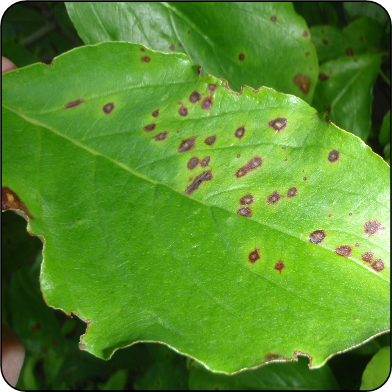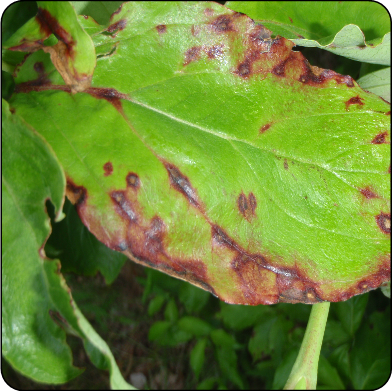Dogwood anthracnose
Information about dogwood anthracnose (Discula destructiva), a foliar disease found in Ontario.
Overview
- Invasive – native to Asia.
- Dogwood anthracnose is an invasive disease, confirmed in Ontario for the first time in 1998; the origin of the disease is unknown, but it is widely considered to be an exotic disease.
- Dogwood anthracnose is a foliar disease caused by the Discula destructiva fungus, leading to damage and mortality in eastern flowering dogwood.
“Invasive” refers to a species that has moved outside of its native habitat and threatens the new environment, economy or society by disrupting local ecosystems.
Host species
Dogwood Anthracnose causes damage to two species: eastern flowering dogwood (Cornus florida) and Pacific dogwood (C. nuttallii).
Characteristics and life cycle
- Leaves in shaded or very damp areas are the first infected.
- Tan-coloured spots and necrotic blotches form on leaves.
- Sometimes these leaf spots coalesce and form large, irregular lesions along the leaf’s edge.
- Leaf spots may die off or merge causing premature leaf drop or shot-hole appearance in individual leaves.
- The infection can spread from the leaves to twigs, buds and fruit, and ultimately to larger branches, where it forms large numbers of elliptically shaped cankers that girdle and kill the branches, and eventually the entire tree.
- In severe cases, the disease may spread down the leaf petiole forming elliptical cankers, which girdle the branches and eventually lead to decline and whole-tree mortality.
Symptoms and damage
- Symptoms of dogwood anthracnose first appear on foliage, visible as small, light brown leaf spots.
- Infection generally occurs during cool, moist conditions of the spring or fall and typically spreads to leaves and trees.
- It causes dieback and mortality in the lower crown before spreading throughout the remainder of the tree.
- The disease kills dogwoods of all sizes, but is most severe on young seedlings and in understory forest trees.


Control measures
There are currently no specific control measures.
Updated: July 28, 2022
Published: July 18, 2014